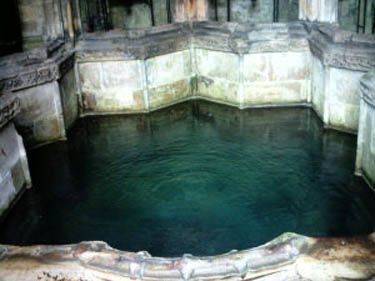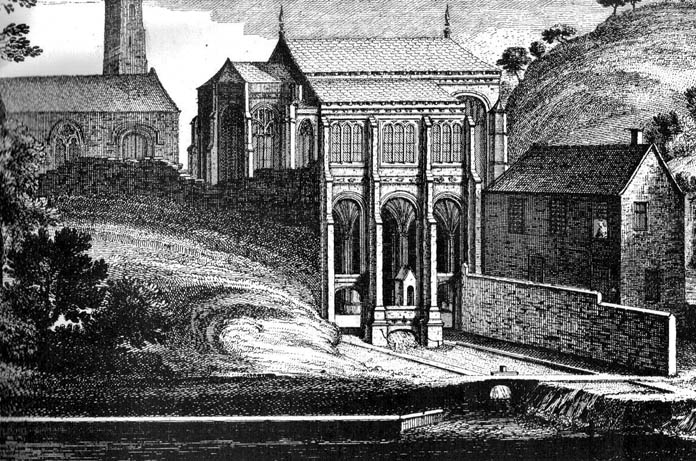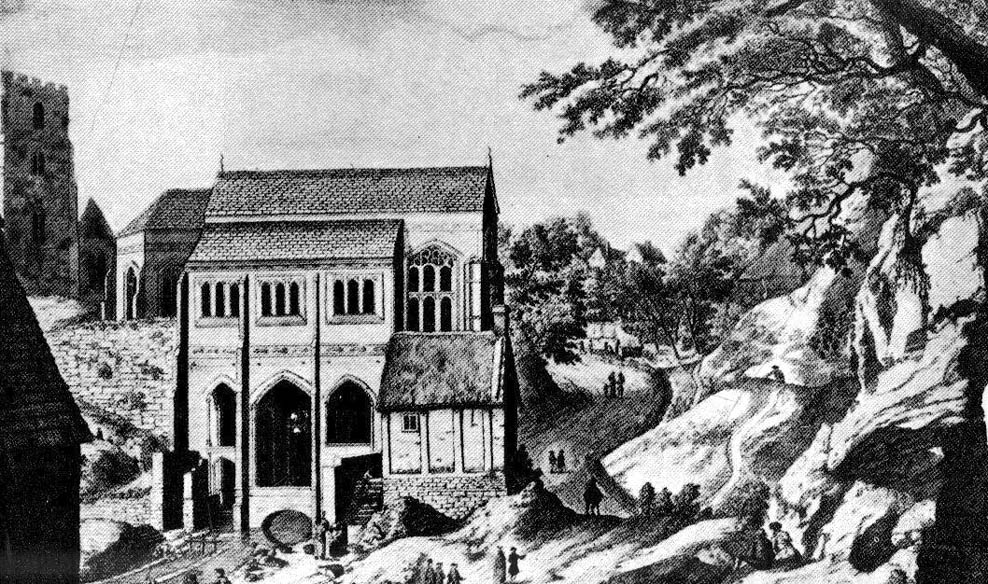Holy Well: OS Grid Reference – SJ 1851 7627
Also Known as:
- Ffynnon Gwenfrewi
- St. Winifred’s Well
Getting Here

From the Chester ring road head into north Wales along the coast road (A548) from Connah’s Quay for about 13 miles taking you through Flint. After 12 miles turn left into Holywell town (Treffynnon). At the western end of the town go down the Greenfield-Mostyn road back towards the A584 taking you down a hill. After 500 hundred yards you arrive at the holy well/shrine and pilgrimage centre on the right-hand side; there is parking on the opposite side of the road. There is a small entrance fee, but as well as the famous healing well and bathing pool, they have a gift shop, toilet facilities and a late medieval/Gothic two-storey structure that is built over the polygonal, vaulted well chamber, whilst at the side (at the corner of the hill) stands another Gothic chapel from 1500.
History and Legend
According to the well known legend, a young Welsh girl called Winefride or Gwenfrewi, was the daughter of patrician parents, Thenith (Thewyth) and Gwenlo, who lived at Bryn-y-Castell (Treffynnon) at the beginning of the 7th century AD. She was a very religious girl who was known for her kindness and charities to people in the area that was then called Tegeingl (after the Decengle tribe). Winefride grew up to be a very beautiful young woman which troubled her because she had no wish to marry, only to live a life of chastity and serve God as only she knew how.

One day a local chieftain from Hawarden (Penarlag) called Caradoc ap Alyn came hunting in the area. He became very thirsty so stopped off at the house where Winefride lived with her parents. However, on this particular day her parents were attending the local church where St Beuno, her uncle, was conducting a service. Prince Caradoc soon began to seduce her so she ran to the church but with the prince in hot pursuit. When he caught up with poor Winefride, she again resisted him so he took his sword and beheaded her. Her severed head fell to the ground and rolled down a hill and where it came to rest a spring of water gushed forth from the ground. Her parents and uncle came rushing out of the church at which point St Beuno cursed the evil prince, who was calmly wiping blood from his sword, causing him to sink into the ground — never to be seen again. St. Beuno then placed the severed head back into place, restoring Winifred to life again but leaving her with a thin scar round her neck.
Later, Winifred was entrusted for her education to St Beuno whom sent her to various holy men including St. Elerius at Gwytherin near Llanwrst. Here she became abbess of a convent that had been founded by Elerius, with his mother St. Theonia as first abbess; and it was here for the next 40 years that Winifred lived out her life. She was said to have died at Gwytherin in either 65o or 670 AD. Her body was first interred in the churchyard there, however in 1138 her relics were transferred to Shrewsbury Abbey. Sadly however, her shrine there was destroyed in the 16th century and now only a few relics remain with a finger-bone being housed at a convent in Holywell.
Mythology and Folklore

The holy well and shrine of St. Winifred at Holywell became a place of pilgrimage during the middle-ages and many miracles of healing were wrought there. The sick were cured of infirmities of the legs and body; crutches were left at the well and many were cured of leprosy, eye complaints, loss of hearing, being not able to bear a child, mental illness, palsy and lung disorders etc. During the Reformation the holy well suffered much, but from the 17th century onwards pilgrims were returning to the holy place and, more recently it has become the Welsh Lourdes and still pilgrims come in droves from all over Wales and beyond. The vaulted Gothic structure covering the well shrine is richly carved with bosses depicting various characters including St Beuno, Earl Stanley, Lady Margaret Beaufort, biblical characters, animals and an abbot of Basingwerk abbey, but there is also much recent graffiti too. A tall statue of St Winefride looks down over the well while candles burn all around. In the larger bathing pool outside, a stone lies at one side — this is claimed to be where St. Beuno sat whilst teaching his young niece. Red stains on stones at the front of the well-basin were long taken to be the martyr’s bloodstains, but now these are thought to be iron oxide pigmentation on the lichens. Today the people still come either to bathe in the special pool, throw coins in the well, or fill bottles with holy water from a tap on the wall. Faith in miracles of healing is still much in evidence here and may it continue to be for many years to come. Everyone is welcome here, you don’t have to be a Roman Catholic!
References:
 Bord, Janet & Colin, Sacred Waters, Paladin: London 1986.
Bord, Janet & Colin, Sacred Waters, Paladin: London 1986.- David, Christopher, Saint Winefride’s Well – A History and Guide, Gomer Press: Llandysul 2002.
- Edwards-Charles, Thomas, Saint Winefride and Her Well – The Historical Background, Holywell 1962.
- Heath, Sidney, In the Steps of the Pilgrims, Rich & Cowan: London 1950.
- Jones, Francis, The Holy Wells of Wales, University of Wales Press: Cardiff 1992.
- Liebreich, Karen, UneXplained: Spine-tingling tales from Real Places in Great Britain and Ireland, Kindle 2012.
- Simcock, Richard, North Clwyd At Random, Countryside Publications Ltd: Chorley 1986.
- Spencer, Ray, A Guide to the Saints of Wales and the West Country, Llanerch: Felinfach 1991.
Copyright © Ray Spencer 2011
Cheers Paul, the site looks pretty good now. Thanks.